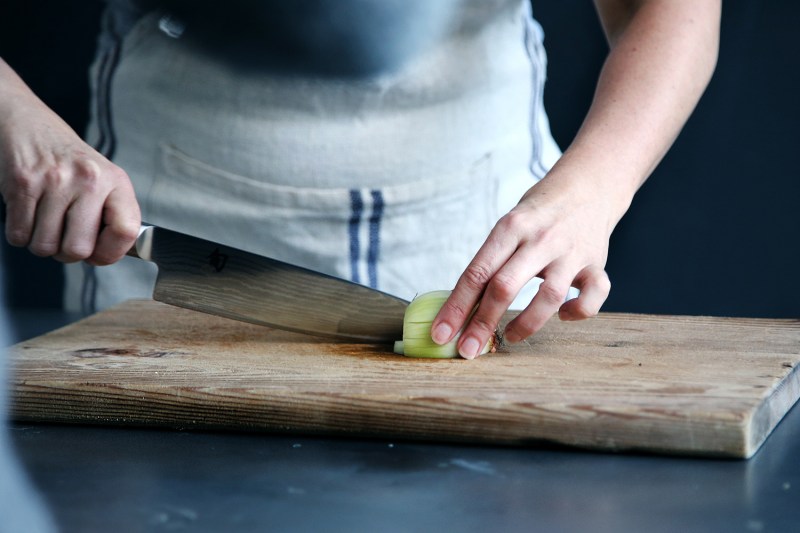
A good blade always comes in handy, whether it’s a certain type of kitchen knife to a timeless Swiss army knife. They help us cut, get out of jams, and make life easier. But they don’t just come together out of nowhere. No, the best knives are made of very specific types of steel.
Knife pros spend lifetimes learning the ins and outs of iron-clad tools and how they come together. You’re welcome to take that deep dive, but here, we just want to outfit you with the essentials. You’ll come away with a better understanding of the craft, whether you’re looking to update a specific piece of cutlery or knife set or even want to try making one of your own.
Let’s take a look at the best steel for knives and what exactly that means.
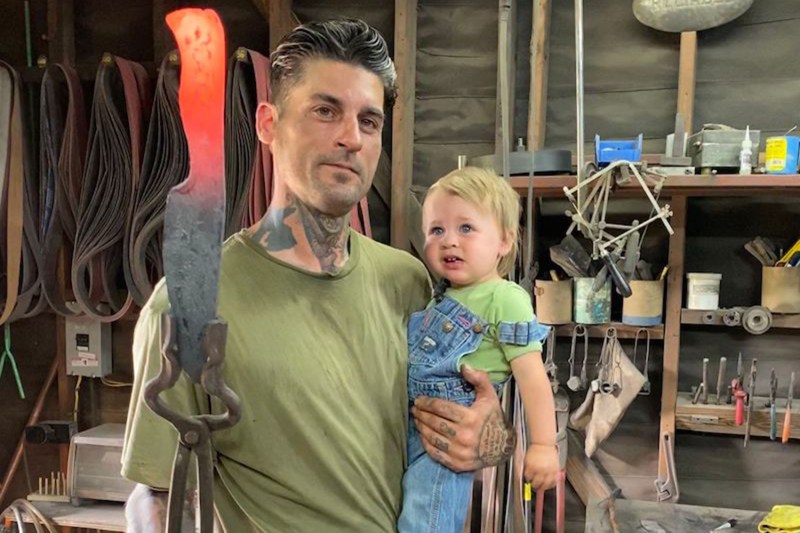
Meet bladesmith DJ Brelje
There’s a big difference between people who like steel and are knowledgeable of it and those who’ve worked with steel all their lives and are intimate with it. DJ Brelje, bladesmith and owner of Maë Knives in Oceanside, California. Brelje has been working with steel all his life. Before he became a bladesmith, he was a welder for over 20 years. You can read reviews and learn about steel from forums, blogs, and online guides all day long (which is what we did). Or, you can just ask a pro (which is also what we did).
What are the most common elements of steel?
You’re not going to find steel on the periodic table. That’s because it’s a man-made substance crafted out of many elements. It’s mostly iron and carbon, but there are many other elements added to the brew that give it other properties.
- Iron is the main ingredient in steel.
- Carbon is one of the most critical factors, as it functions as a hardening element and makes iron stronger. Every type of steel will have some amount of carbon, and often, the amount can be telling of the quality of a blade. Low carbon means there is 0.3% or less carbon in the alloy. Medium carbon is typically between 0.4% to 0.7%, and high carbon is generally considered 0.8% and above.
- Chromium is what makes stainless steel stainless. Technically all steel can rust, but types with more chromium (usually around 12% to 13%) are much less prone to it.
- Cobalt adds strength to the blade.
- Manganese hardens the blade but also makes it brittle if added in high quantities.
- Nickel adds toughness to the blade.
- Molybdenum helps steel maintain strength at high temperatures.
- Tungsten increases wear resistance.
- Vanadium increases wear resistance and makes the blade harder.
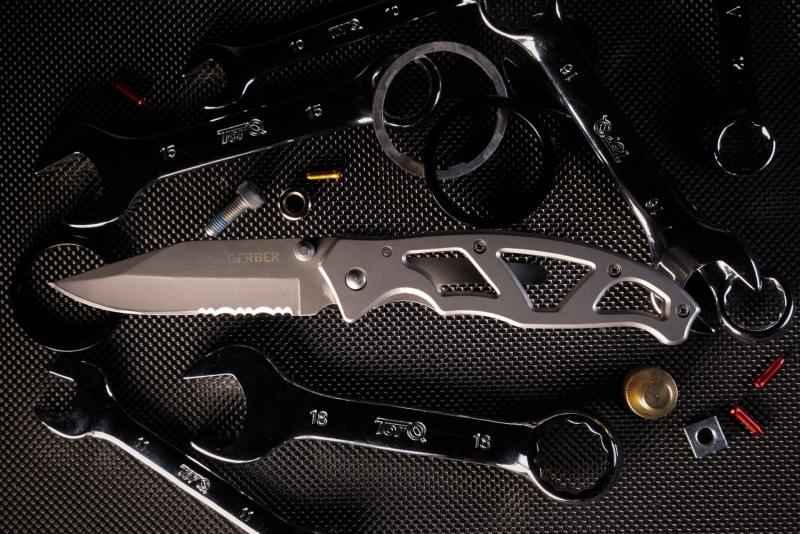
What are the main types of steel?
Steel is used in more than just knives; it’s used to make the majority of things we come in contact with every day. According to the World Steel Association, over 1.9 million tons of steel was produced worldwide in 2022 with over 3,500 different grades. Remember, there are many “types” of steel, but overall, it falls into one of four categories.
Carbon steel
Carbon steel makes up most of the steel production across the globe (90%) and is what most knives will be made from because of its high durability. There are three levels of carbon steel; low (0.30% or less), medium (between 0.30% and 0.60%), and high (between 0.60% and 1.5%). Although very strong, carbon steel is duller and prone to corrosion.
Alloy steel
Alloy steel has a wide array of alloying elements, like nickel, chromium, or manganese mentioned above, which are manipulated depending on the steel’s practical use. Alloy steels are often used in electronics, pipes, or auto parts.
Stainless steel
The term stainless steel is thrown around a lot, so it can often be hard to know if it’s actually stainless steel. But, the main telltale sign of stainless steel is it’s shinier due to high levels of chromium, which make it highly resistant to corrosion. Stainless steel knives are typically a combination of high carbon and contain between 11% and 17% chromium.
Tool steel
Tool steel is used for precisely what it sounds like, tools. Tool steel is incredibly hard and heat resistant thanks to the inclusion of durable elements like tungsten, molybdenum, cobalt, and vanadium.
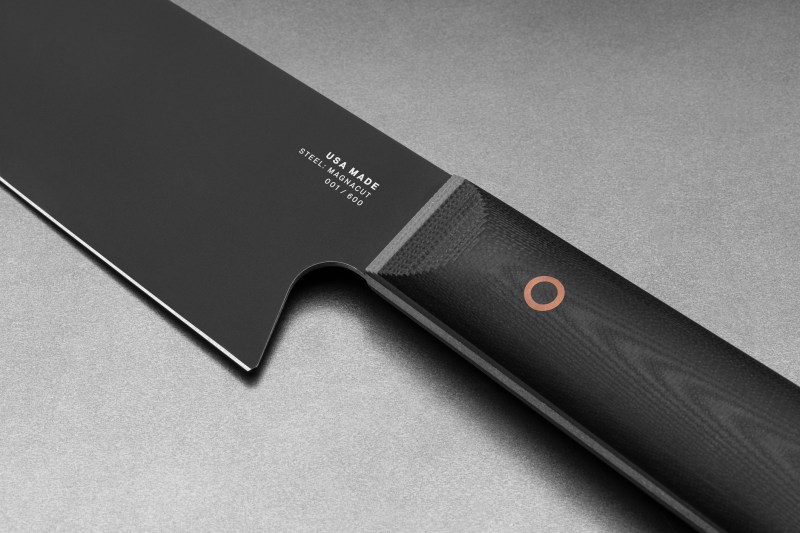
What are the defining characteristics of quality knife steel?
Now that we understand what goes into steel and what the main types are, let’s cover what characteristics a good blade should have. Many of these factors are reliant upon one another. However, some qualities must be given up for others in their chemical composition when developing particular steel. So finding the “perfect” knife can be somewhat of a double-edged sword — pun intended. For instance, when crafting stainless steel, some of the carbon needed for hardness must be given up for elements that contribute to non-corrosiveness, like chromium.
Edge retention or sharpness
The first thing that comes to mind when you think of a knife is its sharpness. After all, its primary purpose is to cut through materials quickly and effectively. A knife’s ability to retain its edge is dependent upon its hardness. On the other hand, a knife that’s too hard is very tough to sharpen. A precise combination of strengthening elements, combined with naturally malleable iron, allows for excellent sharpness and edge retention.
Hardness and toughness
Hardness and toughness may sound like the same thing, and though they are dependent on one another, they aren’t necessarily the same. To understand hardness in steel, you should familiarize yourself with the Rockwell Hardness Scale, which is used to classify hardness in steel. Very high-carbon steel combined with elements like manganese will make the steel very hard yet brittle. That’s why some rigid knives are also brittle and can chip and break easily.
The blade’s toughness is its resistance to chipping, cracking, or breaking from impacts and torsion pressure. Elements that rank mid-range on the Mohs Scale of Mineral Hardness, like nickel, will add toughness to the steel. Sporting and combat knives with shorter, thicker blades typically have high ratings in the hardness and toughness departments.
Wear resistance
Wear resistance refers to the blade’s ability to keep its edge through rigorous use in multiple applications. Hardness and wear resistance go hand in hand because steel with high levels of carbides (carbon) is more wear-resistant, and high-carbon steel is some of the hardest. But, a knife that is too hard will chip or break, and for it to be able to perform, it has to have elements within the steel that make it tough.
Corrosion resistance
Any steel can rust under the right conditions. Yet, steel with high levels of corrosion-resistant elements like chromium (stainless steel) makes it that much harder. Often steel strength and wear resistance are sacrificed for anti-corrosive properties.
Before we jump into all the best types of steel, there’s one more point we need to touch on, and that’s steel grade classification.
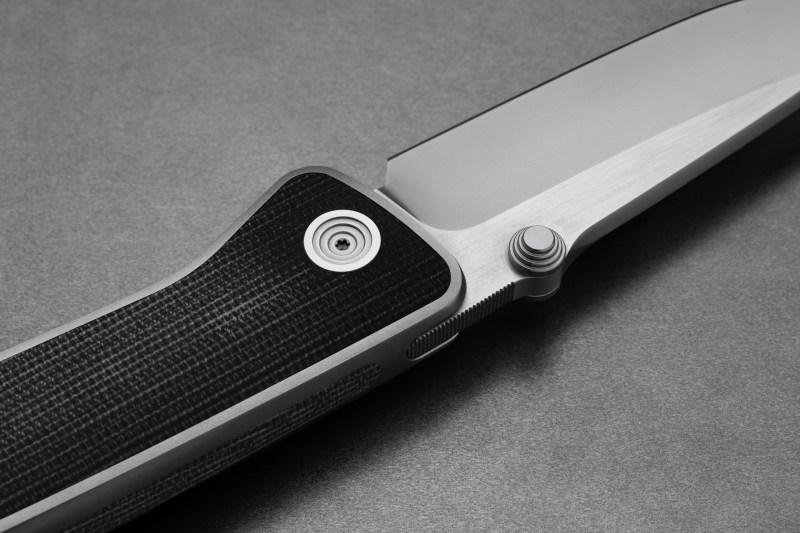
How is steel graded and classified?
If you thought things were a bit too technical before, you haven’t seen anything yet. Steel grading and classification are incredibly complicated, but it’s good to have a basic understanding of how the different types of steel are named.
It’s important to understand that steel is made worldwide, and every country has its own classification system. The SAE (previously Society of Automotive Engineers) grading system is the most commonly accepted in the US. It uses a four-digit code to classify carbon and alloy steel and a three-digit code for stainless steel. With carbon and alloys, the first number denotes the main component. For example, 1xxx is carbon steel (the most common steel for knives). McHone Industries has a great article explaining this topic in more depth.
To make matters more complicated, steel from other countries like Germany and Japan — where many kitchen knives are crafted — has a different grading system. On top of that, steel companies that paten steel they develop will have another name entirely.
It’s important to know all of this when you want to make sure the high-carbon steel knife that a company sells you is actually comprised of high-carbon steel. You can usually track down the type of steel knife manufacturers use on their websites if it’s not stamped on the knife itself. If a knife maker is unwilling to tell you the kind of steel they use, that should be a red flag that the quality isn’t what they claim it to be.
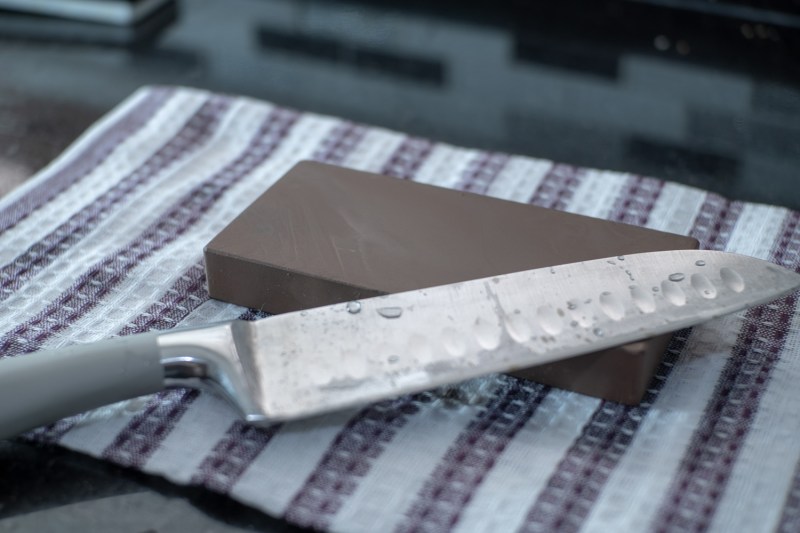
What are the best types of steel for a knife?
The moment you’ve all been waiting for, finally! Well, we hate to break it to you, but in the end, there is no one or two definitive best types of steel. Everyone has a different opinion of what’s the best. Forgers, like Brelje, have a favorite kind of steel. Big knife manufacturers prefer certain types. Then you have knife enthusiasts who have tested endless knives yet still have varying opinions.
The best we can do for you is mention some common types of steel used in very well-respected and high-performing knife brands. Then, unfortunately, you’ll have to do your own research and formulate your own opinion.
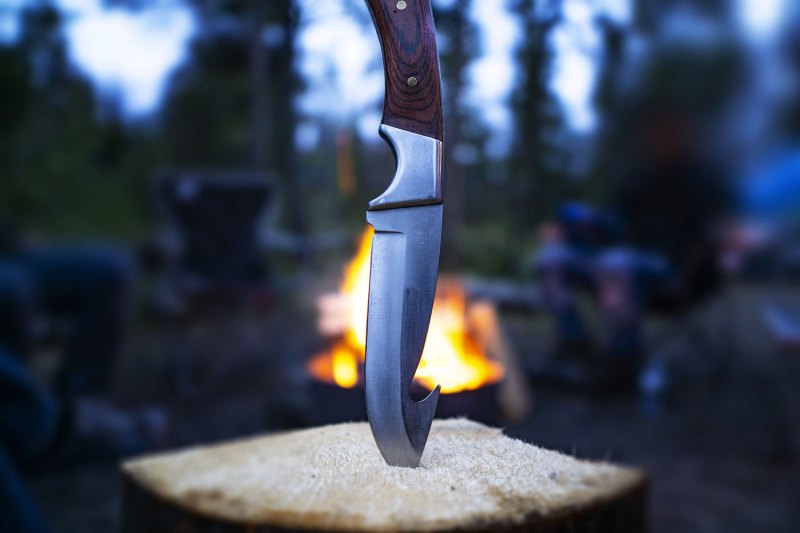
The forger’s favorites – DJ Brelje’s picks for steel
“For me, I look for steel that’s reliable. I feel the reliability comes from working with the same material (steel) until you figure it out and get consistent results.” This list of steel is what you’ll find Brelje hammering away at his workbench.
- 15n20 steel: This is an all-around favorite of Brelje. It’s what he’s worked with the most and feels most comfortable with. It’s hard and tough, and he’ll often forge this steel with 1084 steel to make beautiful, white Damascus steel patterns due to its nickel content.
- 1084 steel: Another steel of frequent use by Brelje. This steel is also used in railroad tracks. It has high resistance to fracturing.
- W2 steel: W2 Steel is highly preferred for outdoor knives due to its extreme hardness and durability. W2 Steel is some of the toughest steel you can find and is excellent for outdoor knives.
- Cru Forge V steel: This is high-carbon steel from Crucible, with 0.75% manganese and vanadium. It can withstand high-heat treatment, and Brelje turns to this steel when he’s looking for superior edge retention.
- 26c3 steel: The steel has the street name of “Spicy White.” That’s because of its 1.25% carbon content with very low alloy content and very pure. It’s extremely hard steel used in razor blades and scalpels.
- 52100 steel: This steel is diverse and can be used for multiple knife applications (kitchen or outdoor). It is hard yet wear and corrosion-resistant. It can be pounded down to a blade with an exceptionally thin edge.
- 80crv2 steel: Just great all-around steel. Also known as “Swedish saw steel,” it’s hard, durable, and wear/corrosive resistant.
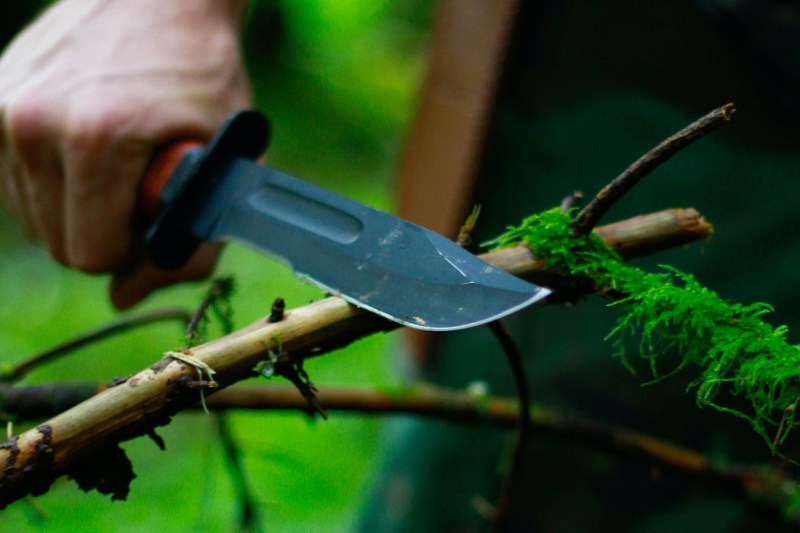
Best steel for outdoor or tool knives
As we mentioned, knives that are designed for utility or tactical purposes need to use tough, hard, and wear-resistant steel so they can hold up to any condition. Here are some of the most commonly used tool steels used in knives.
- A2 steel: A2 steel has higher levels of chromium and carbon and is very tough and durable.
- D2 steel: D2 steel has even higher levels of carbon and chromium with added vanadium and cobalt for added toughness and corrosion resistance.
- M2 steel: M2 Steel is also known as high-speed steel due to its ability to withstand high temperatures without losing its hardness.
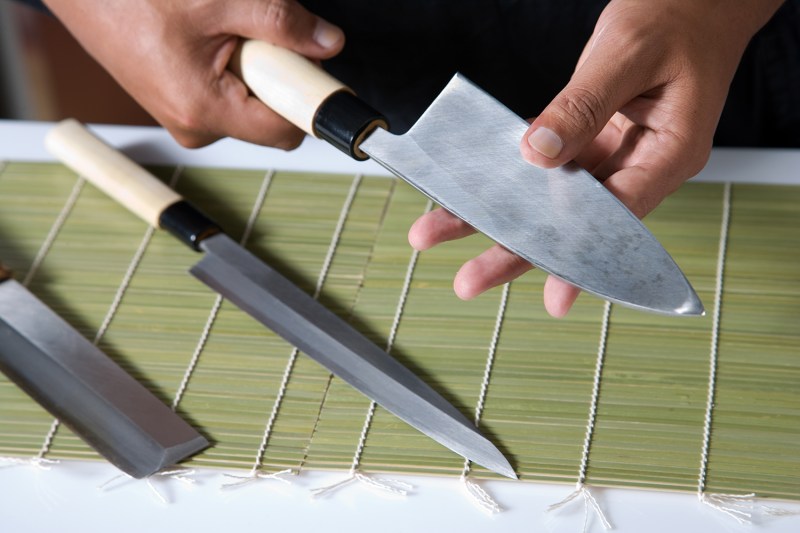
Best steel for kitchen knives
Kitchen knives are most commonly made from high-carbon steel, stainless steel, or a combination of both. Below are some steel brands that you’ll most commonly find on the market.
400 series
- 420 steel: Common in lower-end knives, this steel has about 0.38% carbon. The low carbon content means that it’s very soft compared to most others, and it doesn’t hold an edge well. Blades made from this material need to be sharpened frequently and are more likely to chip. On the bright side, all 420 stainless steel is highly rust-resistant. This makes it an excellent material for diving knives since their constant contact with salt water makes them more likely to rust.
- 425M steel: This is a material similar to the 400 series that has 0.5% carbon. Not a great steel by any means, but it’s not a bad one either, and it’s reasonably tough for the price.
- 440 steel: There are three different types of 440 steel: 440A, 440B, and 440C. The further along in the alphabet, the better it gets. The only problem is that frequently manufacturers simply stamp “440” on the blade’s tang without the letter grade, so knowing what you’re buying is tricky. As a rule of thumb, if it doesn’t explicitly say 440C, it’s most likely a lower-end version like 440A or 440B. Certain knife manufacturers have even gone so far as to rename 440C as other things to differentiate the quality of the product.
- 440A steel: This low-cost stainless steel has a carbon content range of 0.65% to 0.75%. It is the most rust-resistant of 440 steel, and 440C is the least rust-resistant of the three. However, taken as a whole, the 400 series is comprised of some of the most rust-resistant steel you can buy.
- 440B steel: This is very similar to 440A but has a higher carbon content range (0.75% to 0.95%), so it has better edge retention.
- 440C steel: This steel has a carbon content range between 0.95% to 1.20% and is generally considered higher-end steel. It’s prevalent in knives because it provides a good mixture of hardness and corrosion resistance and isn’t expensive.
AUS series
The most significant improvement of the AUS series (which is made in Japan) over the 400 series is the addition of vanadium, which improves wear resistance and provides excellent toughness. This also reportedly makes the steel easier to sharpen.
- AUS-6 steel: AUS-6 Steel has 0.65% carbon and is generally considered low-quality steel. It’s comparable to 420 but with better edge retention and less corrosion resistance.
- AUS-8 steel: This fairly popular steel has 0.75% carbon, which makes it fairly tough. It also has more vanadium than AUS-6, so it holds an edge better. Cold Steel likes to use this stuff a lot in its blades.
- AUS-10 steel: Our final option in this series has 1.1% carbon and is roughly comparable to 440C. It has more vanadium and less chromium than 440C, which makes it slightly tougher in comparison, and a little less rust resistant.
ATS series
- ATS 34 steel: This steel is similar to 154 CM (listed below) and is generally considered one of the best steels you can buy. It has 1.05% carbon, and there are lots of high-end custom knives that use it because it’s just excellent metal. Benchmade and Spyderco seem to be fans of this steel, as you’ll see it a lot in their products.
- ATS 55 steel: This steel (carbon content of 1.00%) does not have the vanadium present in both ATS-34 and 154-CM (see below). This means that it doesn’t hold an edge as well and has also been reported to be less rust-resistant than ATS-34.
SXXV series
This series is becoming quite popular because of its strength, ability to resist rust, and how well it holds an edge. These are difficult steels to sharpen, though, if you do need to give them an edge. All of these knives are very wear-resistant. The 30, 60, and 90 you’ll see in this series stand for 3%, 6%, and 9% vanadium in the alloy, respectively.
- S30V steel: This steel was designed to be used for knives. It’s very tough and yet still has great wear resistance. It has superior hardness for how tough the steel is, too, which is why many consider it to be one of the best choices for knife-making. It has a carbon content of 1.45%.
- S60V steel: This stainless steel has high wear resistance. It has lots of vanadium and also a carbon content of 2.15%. It’s just a step above S30V but is relatively rare in knives because it’s more expensive.
- S90V steel: This steel has superior edge retention, but it can be almost impossible to sharpen due to its ridiculous hardness. You’ll typically only find it in custom-made knives, and it has a carbon content of around 2.30%.
Other noteworthy steels
- 154 CM steel: This is high-quality steel — arguably one of the best available for knives. It has a carbon content of 1.05%, holds an edge well, and has pretty good toughness for how hard the steel is. It is tougher than 440C and is often compared to ATS 34 because the two are so similar. However, some people prefer this steel to ATS 34 since this one is made by Crucible, an American company.
- M390 steel: M390 has 1.9% carbon, is very stain resistant, and has excellent wear resistance. It has vanadium as an additive, and consequently, it’s a popular hard steel. This is also the type of steel used most often for surgical applications.
- N680 steel: N680 has 0.54% carbon. This is another highly stain-resistant and very hard steel, making it good for saltwater applications.
- VG (V-Gold 1) steel: The original in the highly rated VG line of Japanese steel. A bit more carbon and fewer alloy materials than VG-10 and VG-MAX, making it more brittle and prone to chipping if not cared for.
- VG10 (V-Gold 10) steel: Probably the most commonly just Japanese steel on the market. In most cases, VG10 steel is laminated between two layers of softer and more stainless steel.
- VG-MAX steel: The latest in the VG Steel line and proprietary to Shun Cuterly. The steel is very fine grained with added tungsten and vanadium for toughness.
- Aogami/blue steel: A very hard and durable high-carbon Japanese steel from Hitachi Metals. It’s popular among Japanese brands like Yoshihiro. It comes in Blue Steel No.1, Blue Steel No. 2, and Blue Super Steel variations.
- Shirogami/white Steel: Other Steel from Hitachi metals. Considered by some to be the hardest steel available. It comes in White Steel No.1 and White Steel No.2. Be careful; this steel will rust without proper care.
What is Damascus steel?
Damascus steel originated in ancient Syria and was known for centuries to be the finest steel in the land. It was formed by hammering several dozen layers of wootz steel to create extremely strong steel with a distinctive yet decorative wavey pattern.
In terms of Damascus steel today, it’s more often imitated but seldom replicated. That’s because the technique of making Indian wootz steel was lost centuries ago, so now people tend to use whatever steel is available. There’s a lot of imitation Damascus steel out there where manufacturers combine only a couple of types of steel, and then acid-etch the well-known Damascus steel into the blade.
However, some knife makers are staying true to the old ways, like DJ Brelje at Maë Knives. He uses 60 to 200 layers of steel when he makes one of his Damascus-style blades.
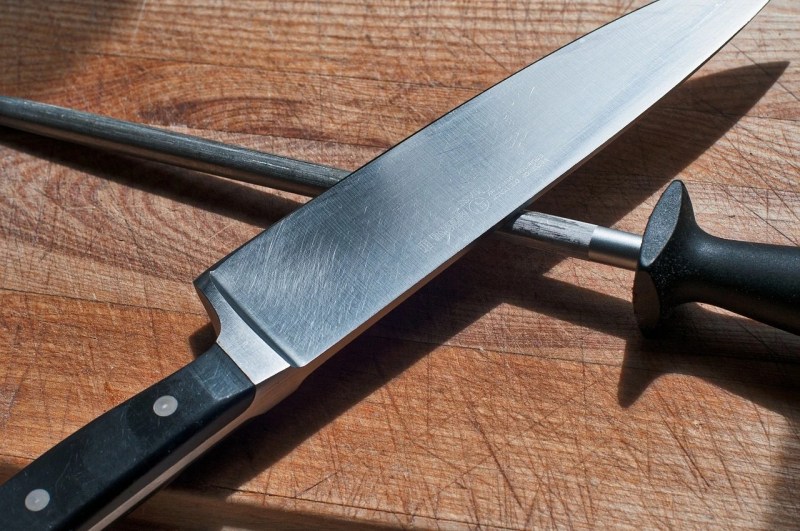
Basic knife care tips
No matter what type of steel is in the blade, no knife is going to last long if it isn’t properly cared for. With proper care, even the cheapest knives can last a long time. With that in mind, here are some basic knife care tips.
- Always keep your knives dry and clean, don’t leave them soaking in water.
- Only wash your knives by hand. Do not put your knives in the dishwasher, as the high temperature can damage the blade and the handle, and the water jets can cause damage to the knife’s edge.
- Dry your knife with an absorbent towel. A paper towel is a good choice.
- Make sure your knives are properly stored. A magnetic knife strip on the wall is a good choice for kitchen knives. Or you can use a knife case or knife roll as well.


